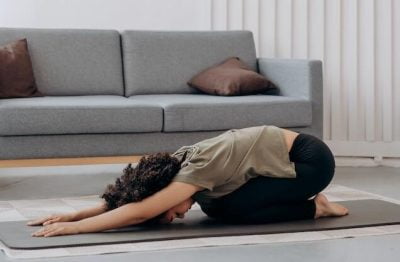 Yin yoga is known for its ability to promote deep relaxation, restoration, and profound inner exploration. Let’s delve into a brief primer. We’ll cover the essence, origins, and the range of benefits Yin yoga offers professionals.
Yin yoga is known for its ability to promote deep relaxation, restoration, and profound inner exploration. Let’s delve into a brief primer. We’ll cover the essence, origins, and the range of benefits Yin yoga offers professionals.
What is Yin Yoga?
Yin yoga is unlike almost any other yoga you’ve heard of. Yin is a gentle, introspective practice that targets the body’s deep connective tissues, like ligaments, tendons, and fascia. It’s not fast-paced or dynamic, like “yang” yoga styles (ex: Hatha, Vinyasa, Ashtanga, etc.).
Yin doesn’t emphasize movement or muscle activation. Instead, it invites us to melt into passive postures we then hold for extended periods.
By letting ourselves “melt and hold,” we explore new layers of our physical and emotional selves. This helps us build profound levels of mindfulness and self-awareness. It encourages us to listen to our bodies, honor our limitations, and find acceptance in the present moment.
Differences between Yin and Yang Styles
Yin and yang yoga represent two contrasting approaches to the practice of yoga. Yang yoga focuses on building strength and heat through dynamic movements and breath. But yin takes a different path.
In yin, we emphasize relaxation, surrender, and cultivating a meditative state. We typically hold postures at least 90 seconds to 5 minutes, or even longer. This specific duration allows for a gentle, yet deep stretch of our connective tissue in ways no other forms of yoga provide.
Benefits of Practicing Yin Yoga
Yin offers a myriad of benefits for both the body and the mind. Key advantages include:
1. Improved Flexibility:
Again, in yin, we specifically targeting the deep connective tissues through long holds. So we can build overall flexibility and joint mobility without strain. We enjoy better range of motion, suppleness in the body, and an increased sense of physical freedom.
2. Stress Relief and Deep Relaxation:
With its introspective nature, yin yoga is a powerful tool for stress reduction and deep relaxation. It allows us to find a state of profound calm and tranquility.
3. Heightened Mindfulness and Self-Awareness:
Through the stillness and prolonged holds, yin helps us get to know our bodies. But not only that. Yin helps us tap into hidden thoughts and emotions, as we’re ready. Through this gentle reconnection, we gain a deeper understanding of ourselves. And we start to recognize both the limiting and empowering beliefs we hold.
4. Balancing Energy Flow:
Yin yoga is intricately connected with the meridian system of Traditional Chinese Medicine (TCM). TCM focuses on the flow of vital energy, known as Qi, throughout the body. By working with the meridians, yin is said to balance our energy, improving overall well-being and harmony.
5. Enhanced Emotional Release:
The “tuned in” nature of yin provides us a safe space to release stored emotional tension and trauma. It offers an opportunity to connect with and process pent-up emotional energy. In this way, we experience faster emotional healing and catharsis.
How Does Yin Yoga Work?
Yin yoga operates on the principle of “fascial release.” Fascia is the intricate web of connective tissue that surrounds and supports all our muscles and organs. By holding postures for extended periods, our fascia rehydrates over time. As it does, its restores its natural elasticity and mobility. And so do we. :}
Scientific research has substantiated the benefits of yin yoga. For instance, studies show practicing it can boost hyaluronic acid and collagen production.
Hyaluronic acid is crucial in helping keep our joints lubricated. And collagen is a protein that supports the strength and integrity of our connective tissues.
Applying Yin for Trauma Recovery
Trauma can have profound impacts on the body and mind, often resulting in a sense of disconnection or dysregulation. Yin can serve as a valuable tool in the journey of trauma recovery. It offers a safe and supportive tool survivors can use to reconnect with their bodies and enhance healing.
Let’s explore how to use yin yoga for trauma recovery:
1. Notice the Impacts of Trauma:
Yin helps us see the ways traumatic experiences may have changed our brain, body, and behavior.
2. Build Self-Care and Mindfulness:
Yin Yoga places a strong emphasis on tuning into ourselves. It empowers trauma survivors to listen to our bodies, honor our own boundaries, and practice self-compassion. By cultivating “present-moment awareness,” we start feeling more stable and grounded.
3. Adapt Yin for Trauma Recovery:
It is crucial to approach yin with sensitivity and awareness, as a survivor. As with all other yoga styles, consider variations on the poses. Always support your physical, mental, and emotional safety by balancing growth with comfort.
What does this mean?
Don’t push yourself beyond your physical, mental, or emotional edge. But also, try not to be afraid to approach it either.
It’s only by pushing ourselves that we’re able to grow. But pushing ourselves too hard can reinforce feelings of instability.
Basically, always listen to your body.
4. Integrate Yin into Your Recovery:
Like other holistic options, yin yoga works best as part of a balanced trauma recovery plan. Partner with qualified experts, like therapists or trauma-informed yoga instructors to support and guide you through your healing journey.
By combining the benefits of Yin Yoga with other evidence-based approaches, like therapy, mindfulness practices, and self-care techniques, you can create an empowering foundation for healing and recovery.
The Bottom Line: An Effective Healing Tool
Yin Yoga offers a unique and potent approach to growth and healing, particularly in the context of trauma recovery. By specifically targeting the fascia and supporting the release of tension, it improves flexibility, personal balance, and a deep connection with the self.
To experience yin yoga’s transformative effects firsthand, consider booking a Somatic Stress-Release session. These 1-on-1 sessions offer personalized guidance from a Registered Yoga Teacher in a nurturing environment.
May your exploration of yin yoga bring you profound insights, peace, and a renewed sense of energetic harmony!

Leave A Comment
You must be logged in to post a comment.